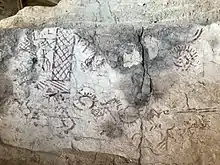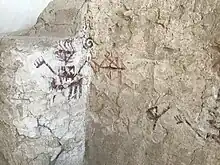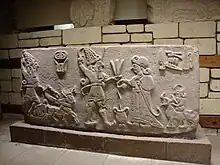 Melid/Arslantepe | |
 Shown within Turkey | |
| Location | Turkey |
|---|---|
| Region | Malatya Province |
| Coordinates | 38°22′55″N 38°21′40″E / 38.38194°N 38.36111°E |
| Type | Settlement |
| Site notes | |
| Condition | In ruins |
| Official name | Arslantepe Mound |
| Criteria | Cultural: (iii) |
| Designated | 2021 (44th session) |
| Reference no. | 1622 |
| Area | 4.85 ha (12.0 acres) |
| Buffer zone | 74.07 ha (183.0 acres) |


Melid,[lower-alpha 1] also known as Arslantepe, was an ancient city on the Tohma River, a tributary of the upper Euphrates rising in the Taurus Mountains. It has been identified with the modern archaeological site of Arslantepe near Malatya, Turkey.[4]
It was named a UNESCO World Heritage Site under the name Arslantepe Mound on 26 July 2021.[5]
History






Late Chalcolithic
The earliest habitation at the site dates back to the Chalcolithic period.[6]
Arslantepe (VII) became important in this region in the Late Chalcolithic. A monumental area with a huge mudbrick building stood on top of a mound. This large building had wall decorations; its function is uncertain.
Degirmentepe
Değirmentepe, a site located 24 km northeast of Melid, is notable as the location of the earliest secure evidence of copper smelting.[7] The site was built on a small natural outcrop in the flood plain about 40m from the Euphrates River.
Early Bronze
By the late Uruk period development had grown to include a large temple/palace complex.[8]
Culturally, Melid was part of the "Northern regions of Greater Mesopotamia" functioning as a trade colony along the Euphrates River bringing raw materials to Sumer (Lower Mesopotamia).
Numerous similarities have been found between these early layers at Arslantepe, and the somewhat later site of Birecik (Birecik Dam Cemetery), also in Turkey, to the southwest of Melid.[9]
Around 3000 BCE, the transitional EBI-EBII, there was widespread burning and destruction, after which Kura-Araxes culture pottery appeared in the area. This was a mainly pastoralist culture connected with the Caucasus mountains.[10]
Late Bronze Age
In the Late Bronze Age, the site became an administrative center of a larger region in the kingdom of Isuwa. The city was heavily fortified, probably due to the Hittite threat from the west. It was culturally influenced by the Hurrians, Mitanni and the Hittites.
Around 1350 BC, Suppiluliuma I of the Hittites conquered Melid in his war against Tushratta of Mitanni. At the time Melid was a regional capital of Isuwa at the frontier between the Hittites and the Mitanni; it was loyal to Tushratta. Suppiluliuma I used Melid as a base for his military campaign to sack the Mitanni capital Wassukanni.
Iron Age
After the end of the Hittite empire, from the 12th to 7th century BC, the city became the center of an independent Luwian Neo-Hittite state of Kammanu, also known as 'Malizi'. A palace was built and monumental stone sculptures of lions and the ruler erected.
In the 12th century, Melid was probably dependent on Karkemiš, where king Kuzi-Tešub ruled. His two grandsons, Runtyas (Runtiya) and Arnuwantis, were at first appointed as “Country Lords” of Melid, but later they also became kings of Melid.[11]
The encounter with the Assyrian king Tiglath-Pileser I (1115–1077 BC) resulted in the kingdom of Melid being forced to pay tribute to Assyria. Melid remained able to prosper until the Assyrian king Sargon II (722–705 BC) sacked the city in 712 BC.[12] At the same time, the Cimmerians and Scythians invaded Anatolia and the city declined.
According to Igor Diakonoff and John Greppin, there was likely an Armenian presence in Melid by 1200 BCE.[13]
Archaeology
Arslantepe was first investigated by the French archaeologist Louis Delaporte from 1932 to 1939.[14][15][16] From 1946 to 1951 Claude F.A. Schaeffer carried out some soundings.
The first Italian excavations at the site of Arslantepe started in 1961, and were conducted under the direction of Professors Piero Meriggi and Salvatore M. Puglisi until 1968.[17][18][19] The choice of the site was initially due to their desire to investigate the Neo-Hittite phases of occupation at the site, a period in which Malatya was the capital of one of the most important reigns born after the destruction of the Hittite Empire in its most eastern borders. Majestic remains of this period had been known from Arslantepe since the 1930s after they were brought to light by a French expedition. The Hittitologist Meriggi only took part in the first few campaigns and later left the direction to Puglisi, a palaeoethnologist, who expanded and regularly conducted yearly investigations under regular permit from the Turkish government. Alba Palmieri took over the supervision of the excavation during the 1970s.[20][21] In the early 21st century, the archaeological investigation was led by Marcella Frangipane.[4]
Early swords and metal trade
The first swords known in the Early Bronze Age (c. 33rd to 31st centuries) are based on finds at Arslantepe by Marcella Frangipane of Rome University.[22][23][24] A cache of nine swords and daggers was found; they are composed of arsenic-copper alloy. Among them, three swords were beautifully inlaid with silver. These objects were found in the “hall of weapons” in the area of the palace.
These weapons have a total length of 45 to 60 cm which suggests their description as either short swords or long daggers.
These discoveries were made back in the 1980s. They belong to the local phase VI A. Also, 12 spearheads were found. These objects were dated to the period VI A (3400-3200 BC).[25] Phase VI A at Arslantepe ended in destruction—the city was burned.
The next Phases or periods were VI B1 and VI B2. This is the time to which the other big discovery at Arslantepe belongs. This is the rich “Royal Tomb” where high quality pottery, and a large number of refined metal objects, made with several kinds of copper based alloys, were found. A sword was also found in the tomb.[26] This tomb is also known as the tomb of "Signor Arslantepe", as he was called by archaeologists. He was about 40 years old, and the tomb is radiocarbon dated to 3085–2900 Cal. BC.[27]
This “Royal Tomb” dates to the beginning of period VI B2, or perhaps even earlier to period VI B1. There’s a considerable similarity between these two groups of objects in the “hall of weapons”, and in the “Royal Tomb”, and the times of manufacture of some of them must have been pretty close together.[25]
Expansion of Kura-Araxes and trade in ores
Arslantepe probably participated in the metal and ore trade between the areas north and south. To the north were the metal-rich areas of the Black Sea coast; ores and metals from there were traded to Upper Mesopotamia in the south. Already during the older Arslantepe VII period, metal objects could be found with a signature of ores from near the Black Sea coast. This makes it probable that some Transcaucasian groups would have been present at Arslantepe already in the fourth millennium.[25]
Also some of the metal artefacts from the “Royal Tomb” clearly belong to Kura-Araxes manufacturing traditions, and the metal analysis even shows provenance from northern Caucasus. All this indicates that the expansion of Kura-Araxes culture to wider areas may have been prompted in part by a trade of ores and metals.[25]
See also
Notes
References
- ↑ "Melid." Reallexikon der Assyriologie. Accessed 12 Dec 2010.
- ↑ KBo V 8 IV 18. Op. cit. Puhvel, Jaan. Trends in Linguistics: Hittite Etymological Dictionary: Vol. 6: Words Beginning with M. Walter de Gruyter, 2004. Accessed 12 Dec 2010.
- ↑ Hawkins, John D. Corpus of Hieroglyphic Luwian Inscriptions. Vol. 1: Inscriptions of the Iron Age. Walter de Gruyter, 2000.
- 1 2 Historical Dictionary of the Hittites, pp. 185-186
- ↑ "UNESCO adds 6000-year-old 'Lion Hill' in Turkey's Malatya to list". Daily Sabah. 26 July 2021. Retrieved 27 July 2021.
- ↑ Frangipane Marcella. The Late Chalcolithic IEB I sequence at Arslantepe. Chronological and cultural remarks from a frontier site. In: Chronologies des pays du Caucase et de l’Euphrate aux IVe-IIIe millénaires. From the Euphrates to the Caucasus: Chronologies for the 4th-3rd millennium B.C. Vom Euphrat in den Kaukasus: Vergleichende Chronologie des 4. und 3. Jahrtausends v. Chr. Actes du Colloque d’Istanbul, 16-19 décembre 1998. Istanbul : Institut Français d'Études Anatoliennes-Georges Dumézil, pp. 439-471, 2000
- ↑ "TAY-Site Age Details". www.tayproject.org.
- ↑ Frangipane Marcella. A 4th-millennium temple/palace complex at Arslantepe-Malatya. North-South relations and the formation of early state societies in the Northern regions of Greater Mesopotamia.. In: Paléorient, vol. 23, no. 1. pp. 45-73, 1997
- ↑ Schmidt-Schultz Tyedje, Schultz Michael, Sadori Laura, Palmieri A., Morbidelli Paola, Hauptmann Andreas, Di Nocera Gian Maria, Frangipane Marcella, New Symbols of a New Power in a "Royal" Tomb from 3 000 BC Arslantepe, Malatya (Turkey). Paléorient, 2001, vol. 27, n°2. pp. 105-139
- ↑ Frangipane, Marcella (2015). "Different types of multiethnic societies and different patterns of development and change in the prehistoric Near East". Proceedings of the National Academy of Sciences. 112 (30): 9182–9189. Bibcode:2015PNAS..112.9182F. doi:10.1073/pnas.1419883112. ISSN 0027-8424. PMC 4522825. PMID 26015583.
- ↑ Federico Manuelli (2019), Carving the memory, altering the past. PUGNUS-mili and the earlier Iron Age rulers at Arslantepe/Malizi (South-Eastern Turkey). In book: Lafer R., Dolenz H., Luik M. (eds.), Antiquitates variae. Festschrift für Karl Strobel zum 65. Geburtstag (pp.227-241) Publisher: VML Verlag
- ↑ J. D. Hawkins, Assyrians and Hittites, Iraq, vol. 36, no. 1/2, pp. 67-83, 1974
- ↑ John A. C. Greppin and I. M. Diakonoff. Some Effects of the Hurro-Urartian People and Their Languages upon the Earliest Armenians Journal of the American Oriental Society Vol. 111, No. 4 (Oct. - Dec., 1991), p. 727.(https://www.jstor.org/stable/603403?read-now=1&seq=8)
- ↑ Louis Delaporte, Malatya. La Ville et le Pays de Malatya, Review Hittites et Asian, vol. 2, no. 12, pp. 119-254, 1933
- ↑ Louis Delaporte, Malatya - Céramique du Hittite Recent, Review Hittites et Asian, vol. 2, no. 15, pp. 257-285, 1934
- ↑ Louis Delaporte, La Troisième Campagne de Fouille è Malatya, Review Hittites et Asian, vol. 5, no. 34, pp. 43-56, 1939
- ↑ S.M. Puglisi and P. Meriggi, Malatya I: Rapporto preliminare delle Campagne 1961 e 1962, Orientis Antiqui Collectio, vol. 7, 1964
- ↑ E. Equini Schneider, Malatya II: Rapporto preliminare delle Campagne 1963-1968. Il Livello Romano Bizantino e le Testimonianze Islamiche, Orientis Antiqui Collectio, vol. 10, 1970
- ↑ P.E. Pecorella, Malatya III: Rapporto preliminare delle Campagne 1963-1968. Il Livello Eteo Imperiale e quelli Neoetei, Orientis Antiqui Collecti, vol. 12, 1975
- ↑ Alba Palmieri, "Excavations at Arslantepe (Malatya)," Anatolian Studies, vol. 31, pp. 101-119, 1981
- ↑ Alba Palmieri, "Arslantepe Excavations, 1982," Kazi Sonuçlari Toplantisi, vol. 5, pp. 97-101, 1983
- ↑ "Oldest Swords Found in Turkey by dekuNukem on DeviantArt". www.deviantart.com. 5 May 2013.
- ↑ Frangipane, M. et.al. 2010: The collapse of the 4th millennium centralised system at Arslantepe and the far-reaching changes in 3rd millennium societies. ORIGINI XXXIV, 2012: 237-260.
- ↑ Frangipane, "The 2002 Exploration Campaign at Arslantepe/Malatya" (2004)
- 1 2 3 4 Hauptmann, Andreas; Heil, Nikolas; Di Nocera, Gian Maria; Stöllner, Thomas (2022-12-30). "Making Copper: Processing in Early Bronze Age Arslantepe (VI B2)". Metalla. Universitatsbibliothek der Ruhr-Universitat Bochum. 26 (2): 113–140. doi:10.46586/metalla.v26.2022.i2.113-140. ISSN 2749-6430. S2CID 256133352.
- ↑ Sword from the Royal Tomb of Arslantepe (after Frangipane 2004, cat. 107). in Vittoria Dall'Armellina 2017, Power of Symbols or Symbols of Power? The "long sword" in the Near East and the Aegean in the second millennium BC.
- ↑ Gian Maria Di Nocera 2015, ORGANIZATION OF PRODUCTION AND SOCIAL ROLE OF METALLURGY IN THE PREHISTORIC SEQUENCE OF ARSLANTEPE (TURKEY). Gangemi Editore spa
Bibliography
- Burney, Charles Allen (2004). Historical Dictionary of the Hittites. Scarecrow Press. ISBN 0-8108-4936-4.
- Louis De Laporte, La porte des lions, 1940
- Vignola, Cristiano, et al., "Changes in the Near Eastern chronology between the 5th and the 3rd millennium BC: New AMS 14C dates from Arslantepe (Turkey)", Nuclear Instruments and Methods in Physics Research Section B: Beam Interactions with Materials and Atoms 456, pp. 276–282, 2019
